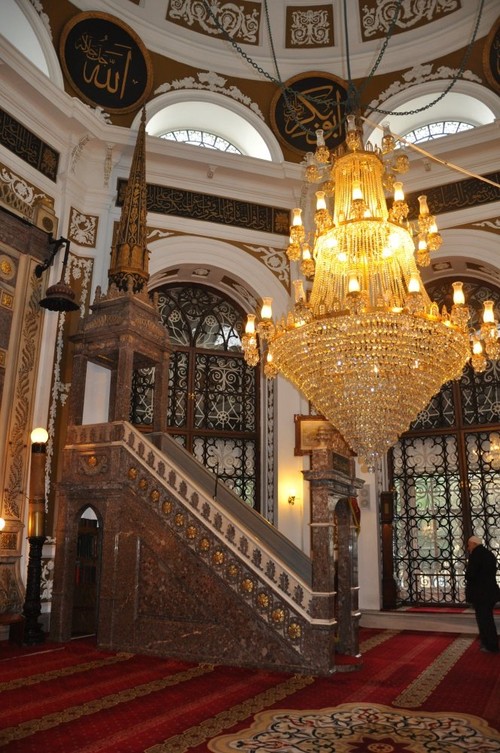© Turkuvaz Haberleşme ve Yayıncılık 2025
The Hırka-i Şerif or Holy Cloak, as it is called since it was worn by the Prophet Muhammad (Peace Be Upon Him), will be open to visitors as a Ramadan classic on Friday June 2, at 10 a.m. in Istanbul's historic Fatih district.
Barış Samir, a 59th generation descendant of Hazrat Owais al-Qarani to whom the relic was entrusted, spoke to Anadolu Agency at the Hırka-i Şerif Mosque where the Holy Cloak is kept.
The Holy Cloak was bequeathed to Owais al-Qarani upon Prophet Muhammad's request, following his death.

Samir explained that Owais al-Qarani went to Medina in order to see Prophet Muhammad, however he was not able to, as the Prophet was on the Tabouk expedition.
After waiting a few days in hope of the Prophet's return, Owais al-Qarani eventually had to go back to Yemen because of his mother's illness.
Essentially, the Prophet Muhammad and Owais al-Qarani could see each other in the intermediate realm, in another dimension.
Upon his return to Medina, the Prophet Muhammad requested that his cloak should be given to Owais al-Qarani.
Hazrat Ali and Hazrat Omar fulfilled his request after his death.
Sometime later, Owais al-Qarani went to Northern Iraq to fight next to Hazrat Ali in the Battle of Siffin and died a martyr there in 657 and the Holy Cloak was inherited by his brother.
In this way, the relic descended all the way to the 59th generation.
Samir talked about the preserving the Holy Cloak at the Hırka-i Şerif Mosque.

"The showcase that protects the relic has a very specific climate control. This air conditioning is year round and continues after Ramadan," he said.
"We have preserved the relic in this room since this mosque was constructed more than 160 years ago. It has never been removed from this room. The Holy Cloak is made of linen, cotton and silk. These cotton patterns were engraved between two linen sheets via silk eyelets," he added.
Samir said that the Hırka-i Şerif Mosque has been under restoration for three years, under the sponsorship of the governorate of Istanbul.
"The restoration is being conducted so meticulously here. Hence, this year again we are trying to clear the visitors area of construction materials. We hope to open the relic to visitors on June 2 at 10 a.m. with a prayer ceremony," he said.
Visitors will be able to view it every day, from 10 a.m. to 6 p.m. on weekdays, and 9 a.m. to 6 p.m. on weekends. Generally, the relic is seen by over one million visitors every Ramadan. It will be open to visit till the morning azan on the night of decree, when the Quran was revealed," he explained.
Talking about the importance of preserving the Holy Cloak, Samir said, "It is an important responsibility to protect the Holy Cloak. It is such an honorable mission to preserve it over 59 generations. Offering the chance for one million visitors to view it is a source of happiness for us and we hope to reach many more visitors in the years to come."
With long lines of eager people wanting to see the Holy Cloak, Samir stated that they are trying to shorten the waiting process for the visitors' convenience and fulfillment.
Samir also added that visitors coming to see the Holy Cloak may also see other relics such as the Sakal-ı Şerif, hairs from the beard of the Prophet Muhammad, a few vests worn by the Prophet Muhammad, the Başmak-ı Şerif, known as the sandals of the Prophet, fabrics from the Kaaba and several belongings of Owais al-Qarani.
He detailed that the holy relics attract visitors from many countries such as Siberia, Africa, the Arabian Peninsula, America and the Far East.
"To all Muslims, I wish a holy Ramadan bringing peace and fulfillment. I wish a month that is free of conflict," he said.
"Here, we offer elevators for the impaired and they do not need to wait in line to view the relics. Please feel free to visit the Holy Cloak during Ramadan," he added.
"Istanbul has hosted most of its holy relics in Topkapı Palace since Sultan Selim's conquest of Egypt in the 16th century where he seized items of the Prophet in the custody of the Mamluk caliphate, along with the control of the global caliphate of the Muslims," he said. "Among them is a battle standard from the prophetic era, a tooth of the prophet and hair from the prophet's beard, as well as his sandals and a bowl he used to use."
